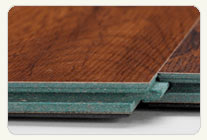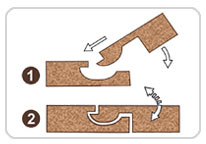One of the latest entries into the DIY home handyman home improvement market places is laminate flooring, as shown in Figure 1. Relatively inexpensive, easy to install and in a wide assortment of colors and patterns.

Figure 1 - Laminate Flooring
Shopping for laminate flooring can be a difficult task. It can be very confusing as most salespeople know very little about what they’re selling. (Just go into a home improvement or remodel center and start asking some questions about their floors). Look at the different laminates with your own eyes, and perform some side by side comparisons with some of the other laminates you’re considering.
Things to look for when purchasing laminate flooring:
The Locking Mechanism:
This is the number one area that most consumers miss. You need to look at the way the boards connect (beware if you receive samples without this important area to test). When connected, there should be as seamless a connection as possible. You should run your hand across the connection. If one side of the connection is higher than the other, that is called ledging. It is important that the seams be very flat.
You also need to consider the thickness of the locking mechanism. Thicker joints will be stronger joints.
Consider the ease of the lock. Is it locked by a lot of force or does it engage easily?

Figure 2 - Laminate flooring locking system
Comparing Locking Mechanisms:
The most disappointing feature of most of the laminates I have seen in the past is the locking mechanism that keeps them together, as shown in Figure 2. Many look fine when they are first installed, but over time they have gradually formed gaps between the seams that make the flooring look less attractive, and more easily allows water to enter the seams. This is due to the density of the core material, the amount of surface area where the lock joins, and overall fit of the two pieces where they come together. If you grasp the thin tongue lock of most products, you can literally break the corner off with just a little pressure between your thumb and forefinger.
Surface Texture:
Look at the surface of the laminate you are comparing.
Does it look flat, plastic like, and lifeless (a look we affectionately call The Kmart Furniture Look)? When you see these flat laminates in larger areas, their flat plastic look screams, I’m not real wood!!!!!!!
Or, does it appear as wood, with a wood grain design that deepens the color and makes the floor look more like real wood?
Wear Layer:
All laminates are made with a wear layer on the surface that protects from wear and tear. However, they do not all have the same quality of wear layer. Laminates are given a rating according to their hardness on the surface:
- AC3 - made for heavy residential and light commercial use.
- AC4 - (60% heavier than AC-3) is rated for heavier commercial use, but is also great in homes where heavy traffic and abusive use is possible.
An easy test you can perform at home can be done by doing a scratch test with several items you may have in your home. Try to scratch all the samples in the same way, with the same pressure and observe the differences.
Core Material:
Compare the center core material of the samples you acquire. You can take your fingernail, or a knife, and pick at the core and see how one may feel softer than another. Look for density in the core as it offers strength, water resistance, and stability. You can also soak the laminate samples in a tub of water overnight to view the differences in how the core performed when subjected to water.
Selection Of Laminate Flooring

8mm Vienna Red Oak Laminate Flooring

8mm Allegheny Oak Laminate Flooring

8mm Mississippi Whitewash Pine Laminate Flooring

8mm Havana Mahogany Laminate Flooring
The Backing:
Look at the back of your samples. Most laminate manufacturers use a thin layer of Melamine to seal the back of their products.
Service:
The last thing to compare is the company offering the product for sale. Will they offer advice and help before, during, (and most importantly) AFTER the sale?
Things to try with your laminate flooring samples:
- Pour straight bleach on them.
- Take some grease, spray on some Pam, rub in ketchup, mustard, anything you like. (Let the kids help….they’ll love this scientific test!) Take a warm, damp paper towel and wipe the mess off. Nothing sticks, no matter how sticky or gooey.
- Lock two pieces together and pour water over the seams. Let it sit on the laminate for a couple of hours. Wipe the water from the top and take the laminate apart to observe what went through the seam.
- Light a match or cigarette. Lay the burning material directly on the surface. Let is burn for 2-3 min. Wipe the spot it made clean with some acetone or nail polish remover.
